Differences between Yilu and Erlu (Cannon Fist):
The body behaves differently, or has a different quality in each form.
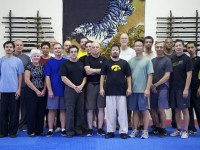 Yilu:
Yilu:
The metaphor for Yilu is a bow and arrow. The purpose of Yilu is to change the body structure into a bow, from which an arrow can be released.
Yin and yang have 3 parts involved. Yin, yang, and the separation between them, like the bow, arrow, and string.
The arrow is not directly attached to the bow. The string is the connection between the two (the relationship between the two)
The bow is hard, structured, and not moving
The arrow is a very different structure, thigly focused, and moving
The string is is the connection or relationship
The bow and arrow have a 50/50 relationship.
Note, the paragraph markers for Yilu are single whips.
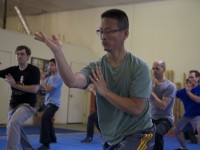 For Erlu, the metaphor is that of a cannon, or a rifle.
For Erlu, the metaphor is that of a cannon, or a rifle.
There are much tighter tolerances than for the bow & arrow; much more stringent. There is also less human effort involved with a rifle than with a bow and arrow.
Yin is the barrel,
Yang is the bullet
Instead of a string the relationship is like gunpowder
There must be strong separation, but not to the point of fragmentation (there may be more separations involves, but not too many or they can never be all re-connected)
Instead of a 50/50 relationship, it must be a 100/100 relationship.
100% moving, 100% not-moving, but must still total to 100%.
Note, the paragraph markers for Erlu are fist covering hand.
In Yilu, the outside is like a T-bar, powering and drilling down through the center
In Erlu, the center/spine is like an engine spinning the outside. Like a helicopter blade.
In Erlu you can only have a single dot, not 2-3 (not a surface)
Pin the joints, stretch the connection / barrel through the body from the (most frequently rear) heel. Then let the bullet out through the barrel.
Once you have the ability / control to not dissapate the energy, the longer the connection / barrel / string, the better.
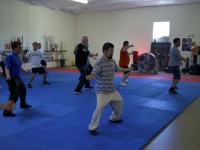 Specific references from form:
Specific references from form:
In the posture of fist and elbow: find the alignment of fist to foot, apply pressure to the fist to find if it’s truely linked to the back heel. If not, find out where it’s leaking and remove the blockage. This may need to be done multiple times until the force applied to the hand connects to the foot. When it does, the difference will be apparent.
The power is from the back heel, as if you were throwing something out, then catching it (throwing out the bathwater, and immediately catching the baby)
In the last move before the 2nd Buddha’s warrior attendant pounds the mortar, after the right foot steps behind the left, define the axis (between the left shoulder blade and spine). Have someone put their finger over that spot, then rotate around that spot (it should not move). The right hand can grasp the left shoulder, so that the right elbow won’t move. Then complete the rotation (for additional power, the elbow can be extended on a line from the left heel)
Random note; When you are being pushed there is a timing in which, just before you start to topple/ move you can stile the opponent’s push, bypasing it and redirecting the push back to the opponent (by stretching through them). This does not involve a specific spot on them, but a specific time.
For the jumps in Erlu, just step at first. Once the alignments and axis are present then they can be added. If you wobble (record to determine if you are or not) go back to stepping.
Jamming vs. Bouncing.
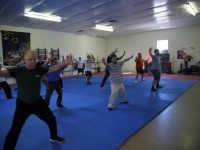 A jam stops at a joint. This can adversely affect that joint.
A jam stops at a joint. This can adversely affect that joint.
A bounce goes past multiple joints, often down to the opponent’s rear foot, and will make them bounce. This is the effect we’re working to produce at this time.
All moves should have the energy eventually get to the floor (both in yourself and in the opponent).
Kua:
The kua should be the joint closest to the opponent, we often try to make it the furthest away, thinking we’re protecting ourselves. It should be the first joint to go in, and get closest to the opponent.
Keep to the instructions:
find someone or something to help you confirm that you’re following the instructions as given. This can be a camera, a spouse or other observer. They do not need to be experienced with taiji; if the observer is a person, tell them what you’re working to do (if not, record what you’re trying to do) and what the feedback points are. Do not trust your own perceptions while doing the move.
Exercises:
1. Tie your waist to a pillar. Your arms can then move freely and powerfully. This is an extension of the back against the wall exercise.
2. Tie a rope to your hand. You can olu move your hand/arm on that line. Move the arm in and out and keep it to that line.
Breathing:
Hung/Ha (Hung should put the opponent on the floor, ha should put the opponent into the air)
Hung – while coming in, should be nasal. Not necessarily an inhalation.
Ha – While going out, should be through the mouth. Not necessarily an exhalation
Dantien:
The dantien should be doing the opposite of the motion.
If a movement goes out, the dantien should rotate as if to go in (in the opposite direction)
If a movement comes in, the dantien should rotate as if to go out
Bolt gun: Cannon fist is like a bolt gun (a device used to kill cows).
The business end should be placed against the contact surface, and then the practitioner should explode along that line, contained within the defined structure.
 Splitting the elbow and hand:
Splitting the elbow and hand:
There are joints that move together (like both shoulders) that need to be split apart, some need to be more connected and aren’t: the elbow and hand are the most obvious of these). This increases power, like a screw instead of a nail.
The screw doesn’t move, the threads don’t move. The wood that is being affected moves up the screw. This is the low-speed, drill-like action of the spiral.
Exercise: The instructions are to place the fist against the opponent’s torso. Lock the fist in place, then align the elbow into the same line as the hand (drop the elbow ever so lightly, it should already be pointing down). Then expand another joint (kua for example) into that line. If the opponent is maintaining steady pressure, this should affect their balance. The line doesn’t move, The alignment and relationship must be like a stick.
Power:
Power comes from locking one part of the body, then moving another.
Strategy:
Find what the opponent is keeping steady, and make it shakey.
Triangulation:
This refers to adding simple, single vectors to the body one at a time, until the opponents body is locked from joint to joint.
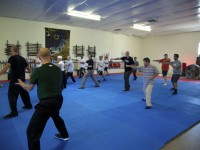 Disappear:
Disappear:
Every body part, but the hands, feet, and head have to disappear. They cannot be perceived by the opponent’s force. If they protrude and can be detected, they need to be polished away. Become as a ball (so that the opponent can only feel the single point of contact). You need multiple contact points to pick up a ball. Remove all protrusions, don’t allow the opponent to try to go through you to the other side. Only allow them that one contact point.
September 21, 2014
Anchor point:
The point you anchor from does not have to be in your body, or in the opponent’s body. It can be a point in space. You just need to anchor from it, and it needs to not move.
Pushing and pulling are essentially the same, they’re different directions on the same track. Yilu sets up that track.
Negative circle exercise –
Anchor the hand to the opponent’s torso (have them hold it). Then pull a little bit of skin at the elbow away from the and you, parallel to the feet). Grind the near heel, while following that pull with your elbow to pull them that direction.
Positive circle exercise –
Touch the opponent on the torso with the positive circle. Find where they’re solid, then lock that arm, and grind with the opposite foot.
Tetragrams
Broken line is for a disconnection in the phsyical relationship of the body on that vertical height.
A solid line is for a connection of the physical relationship body on that height.-
There are many combinations, and can be used to format body motions (rather than images, as 1s and 0s)
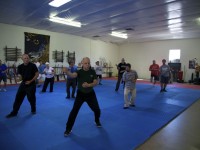 Ligaments
Ligaments
Your ligaments should be like the brake cables on a bicycle. Steel cables inside tubes.
You do not want your motions to be muscles flexing, but like ligaments.
Stretch, if you’re on the right line, the ligaments will engage (this will take some work to get to full function)
If you’re not on the right line, you can tell by the muscle flex, and you’re just using muscle.
Leg sweeps:
The leg sweeps were once down on the ground actual leg sweeps. Practice them that way occasionally so that they can be used that way if needed.
Train ride the donkey backwards with both hands on the floor on occasion, to make sure the feel is right if you ever need to use it that way.
Differential:
This is different body parts going different distances in the same amount of time, like a small and large gear (as in twisting towel). You need this in order to avoid just making pretty patterns in the air with your hands.
Warping:
You want to start with 2 rods in the body. If they both bend the same way (back and front, left and right, top and bottom) then that’s just curvature. Warping is doing two different curves or shapes (rod lengths or curves) in (for example) the front and the back. The instruction for practicing this is to have two rods in the body, either front/back or left/right, and lengthen one, but not the other. Have someone push on you when doing this, and experiment with what happens.
Shoulder 360
There are a lot of hidden 360 moves in this form.
In plum flowers, the right arm goes across to the left, then all the way back to the right on the fist covering hand that follows.
Move using the top of the shoulder on the first part, move until you feel fight from the opponent, then lock the top section, and rotate from the bottom. This switching is similar to switching hips, and should be accomplished without obvious motion.
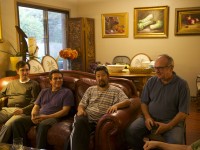 Joints
Joints
This of the joints as a relay station. You can interact with a force, place it for a time so you can deal with another, then come back and interact with the first one from the joint like this. The mechanics of this are similar to triangulation.
The joint can be used as a proxy. For example, if My hand is on you, connected to my back, I can insert my elbow in place of my back.
As far as my force is concerned, that elbow now is a proxy for you.
As far as your force is concerned, that elbow is now a proxy for my back.
This allows me to move without you knowing it, and I can then affect you with a surprise.
Another option is to stretch, and then affect the opponent someplace else, for example via warping.
Exercise:
Lock a spot, stretch from it , lock a different spot, stretch from it, lock someplace else… similar to triangulation.
Fist protecting heart:
This is not a punch, but a fist-elbow switch, done via rotation.
Hand covering fist
This is an intercept, and a punch at exposed area near armpit. Not a one-two, but a one in timing.
Waist:
Don’t bend at the waist, the waist should be like a tower, unbroken.
Spinning flowers from the sea bottom:
After the left fist – right foot split, there’s a big rotation to the left, followed by a big rotation to the right (spinning a big wheel). Don’t move the center once returned after the split until ready to put the foot down.
Kua:
Most of us are making our stepping too large for our ability. Practice with lifting the front leg and hooking it behind the back to make sure there’s stability, Try this after each move occasionally to make sure the stability is present.
Desynchronization:
The top and bottom must be desynchronized. One can move, the other must be stable.
Elbow:
The elbow must always be towards the center. Every body part must conform to the princples. The elbow is the hardest, it seems that no matter what we do, it’s always pointed away from center. Must change this so that it points towards the center. The elbow should also not go more than 3″ from the ribs.
Understanding:
You can only understand taiji by doing it. If you claim to understand it by thinking about it, you’re not understanding it, you’re playing a logic game. You must do it to understand it.
Power:
Power should be like toothpaste, squeezed from a tube, grind all protrusions out. You should not feel the shoulders or elbows, only hands, feet, and head.
Cross hands:
The hands should open like an umbrella.
Knees:
If you need to go down, use the knees, don’t change the waist.
2 quotes on taiji fighting:
To gain stragegic advantage, you must fisht for/on the meridian (use structural spots)
To produce the element of surprise, you must turn over the joint.
Shuttle:
Either pull them into you to hit them on the inside of a drum, or hit the outside edge of the opponent at the outsie. Don’t go after the middle, bypass it.
White snake:
Stay stright-on at opponent, hands may turn, but center line is straight at opponent.
Flash the back
jump / step into step forward with fist should be at 45. The steps/jumps following that are on a straight line.
Movement following posture of fist and elbow after long line of straight jumps ** look up the name
Close the opponent’s body by having the hand decent at a 45 degree angle near head-height.
3 hat exercise (iron hat)
Put a lid/iron hat on the body at the shoulders, hips, and knees. These spots should be weighted down and stable, not bouncy or springy. This will lead to power reaching the foot.
Have someone press down on each in turn (shoulder, hip, knee). Make sure none of them are rising or moving.
Posture of splitting
The setup to this should be to get soooo small, there’s no room inside for anything else. The splitting itself should be so large there’s no room for anything outside it. Hook the front leg behind the back while getting small.
Unnamed move right before 45 degree kick with left foot/right hand.
The expansion should be to the sides. set the hands at a size to match the feet, then expand to full elbow extension.
Full elbow range rather than down.
The move following the left kick is a sucking move.
Yin/yang reversal, pull yourself into the next move, as if puling into a bar. Practice this throughout the form. There needs to be strength both going out, and coming in, not just going out.
Power during these kicks:
The hands should be stretching, as if they were able to touch two walls on a narrow alley.
Long stepping move (plant flowers reversely)
Should be done with 3 steps, done with 2 for reasons of space
Fist comes out of the den:
Your right fist grabs the opponent, and pulls them in so that they fall into the fist-upwards extension.
Circles:
The circle should not be done stationary, this is a work-around to train with little space. It’s ideally trained with continual forward stepping. This should resemble a sine wave, with the hand, then the foot, then the hand, then the foot going out (think standard stepping circles, but not back and forth, just keep going).
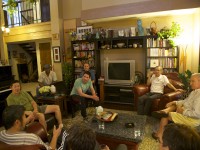 Exercise
Exercise
Hold onto your opponent’s arm. Pick a point in space (have a third person keep a finger marking that spot). Move every part of the opponent (arm, body, leg) through that point.
More advanced exercise:
Don’t let them know first, make them fight you, then keep them going through that spot.
Make the other person into a long tube with slots (joints)
Each slot can represent a dimension. Lock these joints independently (using triangulation). The tube must be locked. Energy can then be applied at the weakest spot (a joint).
Exercise:
Have opponent push onto your chest near a shoulder. Grab their opposite shoulder/back with the hand furthest from theirs, and pull the pushing arm into you, locking it into place. Then, using the free hand (and NOT moving that shoulder at all) cut their elbow. They should collapse downwards. Most frequent error is moving the shoulder.
A spiral motion will find the soft parts of the body.
A straight punch will find the hard parts.
Think of a screw/screwdriver instead of a hammer and nail.
Become a jerk. (Learning to produce and handle jerks)
Exercise:
Free stand with your arm out straight ahead.
Have a partner shove your arm enough to move it swinging across your body.
You are to try to spiral that in such that your fingers don’t leave the space you were pointing towards.
Exercise:
Have an opponent push you in the chest hard enough to send you backwards.
Separate your shoulders and throw your arms forward so tat you don’t need to step backwards.
Experiment with both of these exercises.
Caveat: The above are my notes from the Cannon Fist seminar in Phoenix Arizona. Any inaccuracies or misunderstandings are my own, not from the original content. Please let me know if there’s corrections that need to be made, or augmentations from others who took notes.


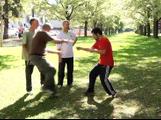
{ 6 comments… read them below or add one }
Kudos to you Aaron for putting out such an excellent collection of notes. I am always very impressed when students of Master Chen are able to document their experiences in a seminar with such clear note taking. I for one am very thankful to you for your efforts.
I agree with Patrick completely. Excellent notes. Thanks!
Thank you Aaron! Very helpful, much appreciated.
Thanks Aaron for your notes. There’s one more note I’d like to contribute. Practice Cannon Fist as fast as you can (with clarity). Master Chen said the Cannon Fist could be done in as little as one and half minute. This requires strong heart and lung. (my word)
Thanks for the extensive and detailed notes. Well done!
I’m not training Cannon Fist but these notes are indeed very helpful/interesting.